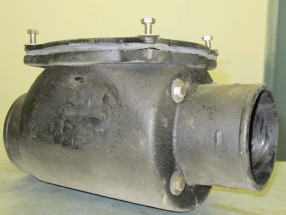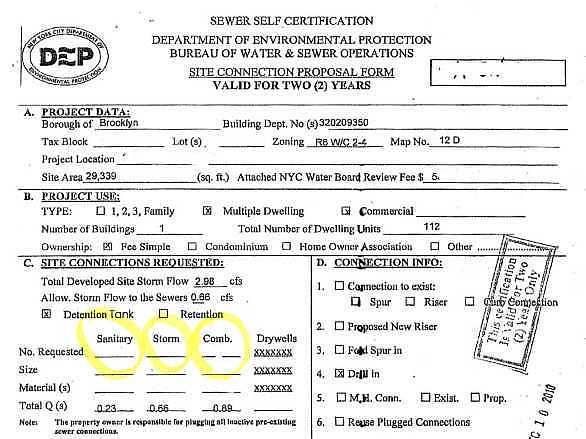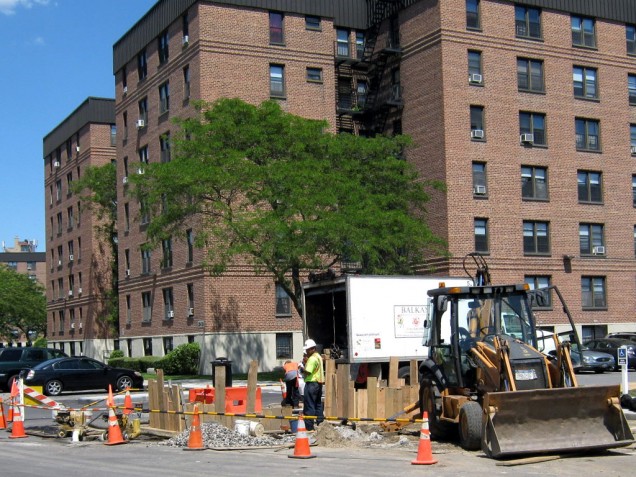
Homeowners in distress routinely express interest in installing a sewer check valve (also known as a backwater valve) as a solution for back ups from public sewer overflow.
At various locations across NYC the past building boom may cause the public drain system to be overburdened and not able to handle the flow of waste and rain water. Sometimes this overflow will back up through a house sewer and cause a property owner a lot of distress.
Unpredictable weather such as extremely heavy rainfall, flash floods, and even a recent hurricane have exasperated this condition. City sewer back ups now occur even more frequently. These back ups usually result in damage and expensive clean-ups. Naturally people that are affected by this condition look for a sensible sewer repair solution for this situation.
City sewer back ups affect a property owners

If the water level in a city sewer rises to a level above a house sewer the water will seek to escape from the house sewer. This because water seeks its own level. In many instances a sewer check valve (also called a backwater valve) can be installed to greatly reduce backwater escaping back into a house sewer.
This type of sewer repair should be performed by a licensed plumber. To have a city system overflow and attempt to level off in one’s basement is not a pleasant situation to say the least.
There are 3 different types of public sewers
Part of understanding the problem is knowing the different types of pubic sewers that exist. A public storm sewer system accepts rain water from buildings whose roof leader lines and area drains are connected to the house sewer, and from catch basins and detention tanks that area connected to the public system.
A combined sewer system is a system that accepts both sanitary and storm water flow. A sanitary public sewer system will strictly accept sanitary waste water flow, but in some cases has catch basins located in the street connected to it.

When a sewer check valve is ‘a bad idea’
In some cases a sewer check valve isn’t a proper sewer repair to address public back ups. Additionally these type of devices must be installed in the correct location to serve the purpose. A frequent error made in this installation is to install the sewer check valve on the ‘house side’ of the trap. This is not a correct installation point and will create serious issues because water from a public waste system will reach the trap before the check valve.
If a public system overflows a sewer trap cover under pressure can leak or actually blow off defeating the entire purpose of the backwater valve. Sewer check valve or back water valves should always be installed on the street side of the house trap. Installing it in this correct manner ensures water overflow from a public sewer system has no opportunity to release into a property prior to the backwater valve closing and reducing the flow.
[button link=” https://balkanplumbing.com/automatic-backwater-valve-solution-stop-sewer-water-flooding” size=”large” style=”alert” color=”red” bg_color=”BLACK” border=”BLACK” text=”dark”]NEW PRODUCT UPDATE[/button]

If a property has a sanitary house sewer that receives rainwater from an area drain for instance, a sewer check valve should not be installed. That would mean that properties that have leader lines, area drains or trench drains connected to the same house sewer that accepts the sanitary water shouldn’t consider this particular sewer repair unless they redo their drain system first or have a licensed plumber check over the situation first.
If a property has a house sewer that accepts both sanitary and storm water (a combined sewer system) it must have an outlet for the rainwater. If the sanitary and storm water flow are combined inside the building another issue arises. Once a sewer check valve closes there is no place for rainwater to escape if there is no outlet. Properties that have a combined house sewer should be carefully inspected by a licensed professional before sewer work is commenced.

Larger multifamily buildings are also typically ill-suited for a backwater valve as a proper sewer repair unless the house drainage system is redesigned first. As stated already once a back water valve closes water no longer may pass to the public sewer until the water level recedes.
In a multifamily property that means the potential of multiple families using water while a backwater valve is simultaneously closed. That would leave no outlet for the sanitary water, which will still result in a back up.
Plumbing problems should be carefully analyzed before any work is started. Trust a licensed NYC plumber to find the right solution. When it concerns complex sewer service issues there is no simple answer, even an issue with a relatively simple fitting like a backwater valve.
About Joseph L. Balkan, Inc.

Balkan Sewer And Water Main is the largest sewer & water main replacement company in NYC. We are licensed, bonded, and insured. As a family run business in continuous operation for over 60 years. Our 10year unconditional guarantee* on replacements means that we continue to stand by our work, long after the job is done. We are expertly equipped, from our 48,000 square foot facility to dozens of trucks, heavy moving equipment, backhoes and pneumatics.
Choose Balkan Sewer And Water Main for your next sewer repair, water main installation, water repair, water line leaks, NYC DEP violations, sewer replacement, water line replacement, sewer trap, backwater valve, hydrants, manholes, specialty water main work, area drain, and trench drains.






